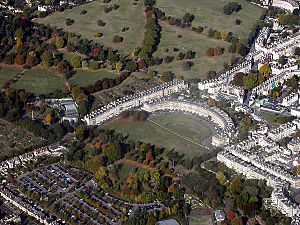John Wood, the Younger facts for kids
John Wood, the Younger (born 1728, died 1782) was a famous English architect. He mostly worked in the city of Bath, Somerset. His father, John Wood, the Elder, was also a well-known architect. John Wood the Younger's building designs were very important in the 1700s. The Royal Crescent in Bath is one of his most famous works. It's a top example of Georgian Neo-Classical architecture in Britain.
Contents
Who Was John Wood the Younger?
John Wood was born in 1728. This was the same year his father moved to Bath. He was baptised at Bath Abbey. His father taught him how to be an architect. As a young man, he helped with some of his father's projects. One of these was the Liverpool Town Hall.
In 1752 or 1753, he married Elizabeth Brock. They had two sons and at least eight daughters. John Wood the Younger passed away on June 16, 1781. He died at Eagle House in Batheaston, which was his home. He was buried next to his father at St Mary's Church in Swainswick.
What Did John Wood the Younger Design?
John Wood the Younger started his own career by continuing his father's work in Bath. His first big project was finishing the Circus. His father had passed away shortly after starting it. Next, he designed and built Gay Street. This street connected Queen Square and the Circus. These were two of his father's greatest designs.
For many years, Wood designed new buildings in Bath. He created large terraces and special architectural pieces. His designs showed new styles and ideas popular in the 1700s.
The New Neo-Classical Style
In the 1770s, a new style became popular. It was called Neo-Classical. This style was simpler and less decorated. Wood was one of the first to use this new style. You can see it in buildings like the Hot Bath. He also used it for the Royal Crescent and the Bath Assembly Rooms.
These buildings looked different from his father's designs. His father liked more detailed and decorated styles. For example, his father's Circus has many decorations. But the Royal Crescent, designed by his son, is much plainer.
The Royal Crescent: A Masterpiece
The location Wood chose for the Royal Crescent was special. It connected his buildings with the countryside. Before this, buildings in Bath were very urban. They looked inwards. But the Royal Crescent was open. It looked out onto open fields.
Today, the city has grown around it. But when it was built in 1775, it was on the edge of Bath. There were no other buildings blocking the views. The Royal Crescent is one of the best examples of Georgian architecture. It is a very important historical building.
Other Important Works
Outside of Bath, he designed other notable buildings. These include Buckland House in Buckland, Oxfordshire. He also designed the General Infirmary in Salisbury. In 1781, he wrote a book. It was called A Series of Plans for Cottages or Habitations of the Labourer. This was one of the first books in Britain about designing homes for workers.
Why Was John Wood the Younger Important?
John Wood the Younger is a very important person in architecture. He is key to the history of Bath. When his father died, Queen Square and the Circus were separate buildings. His son connected them. He then created a whole new part of the city. This area was filled with elegant buildings. They followed the Palladian and Neo-Classical styles.
Wood's clean, Neo-Classical style inspired other architects. These included John Pinch the elder, John Pinch the younger, and Thomas Baldwin. The Royal Crescent is his greatest achievement. It was one of the first designs of its kind. Other towns copied this design. You can see similar crescents in Buxton, Brighton, Bristol, and London.


